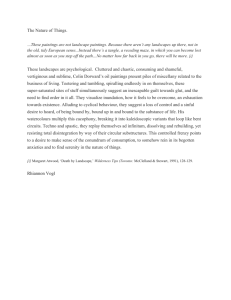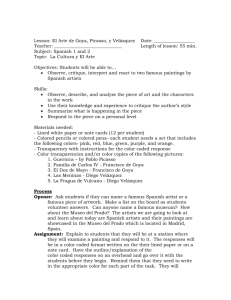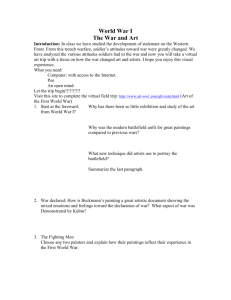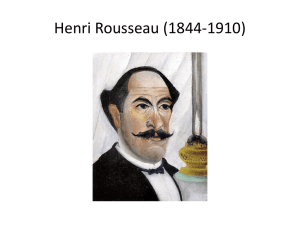Five Frequent Topics of Western Painting
advertisement
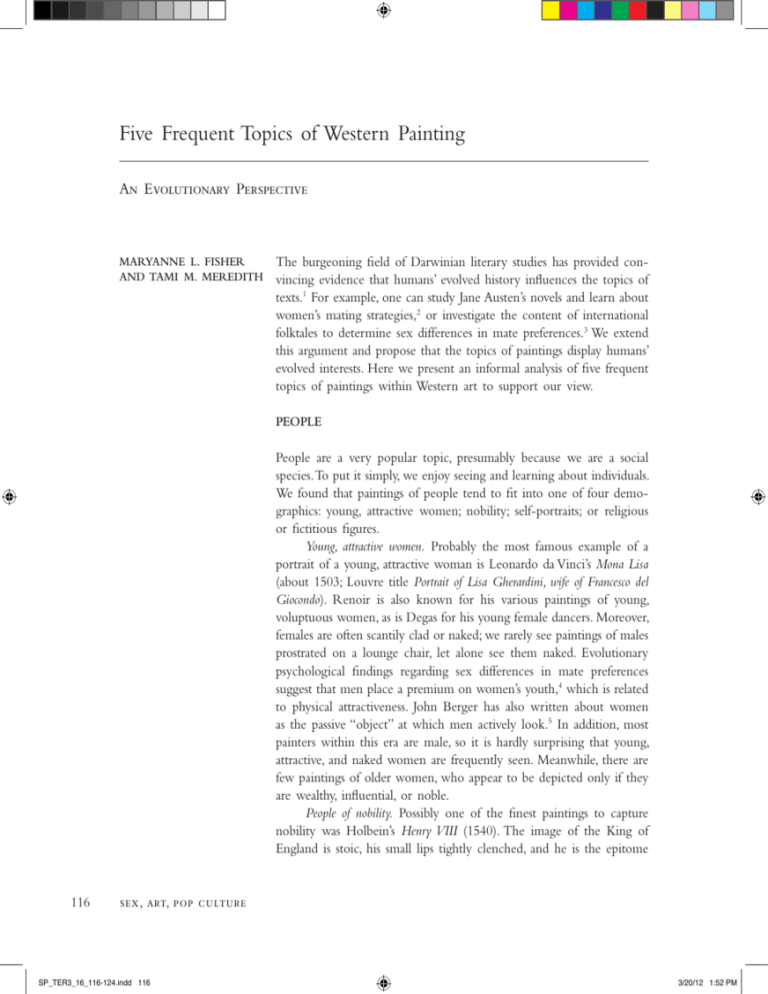
Five Frequent Topics of Western Painting An Evolutionary Perspective Maryanne L. Fisher and Tami M. Meredith The burgeoning field of Darwinian literary studies has provided convincing evidence that humans’ evolved history influences the topics of texts.1 For example, one can study Jane Austen’s novels and learn about women’s mating strategies,2 or investigate the content of international folktales to determine sex differences in mate preferences.3 We extend this argument and propose that the topics of paintings display humans’ evolved interests. Here we present an informal analysis of five frequent topics of paintings within Western art to support our view. People People are a very popular topic, presumably because we are a social species. To put it simply, we enjoy seeing and learning about individuals. We found that paintings of people tend to fit into one of four demographics: young, attractive women; nobility; self-portraits; or religious or fictitious figures. Young, attractive women. Probably the most famous example of a portrait of a young, attractive woman is Leonardo da Vinci’s Mona Lisa (about 1503; Louvre title Portrait of Lisa Gherardini, wife of Francesco del Giocondo). Renoir is also known for his various paintings of young, voluptuous women, as is Degas for his young female dancers. Moreover, females are often scantily clad or naked; we rarely see paintings of males prostrated on a lounge chair, let alone see them naked. Evolutionary psychological findings regarding sex differences in mate preferences suggest that men place a premium on women’s youth,4 which is related to physical attractiveness. John Berger has also written about women as the passive “object” at which men actively look.5 In addition, most painters within this era are male, so it is hardly surprising that young, attractive, and naked women are frequently seen. Meanwhile, there are few paintings of older women, who appear to be depicted only if they are wealthy, influential, or noble. People of nobility. Possibly one of the finest paintings to capture nobility was Holbein’s Henry VIII (1540). The image of the King of England is stoic, his small lips tightly clenched, and he is the epitome 116 sex, art, pop culture SP_TER3_16_116-124.indd 116 3/20/12 1:52 PM Figure 1. King Henry VII, 1535–40, Circle of Hans Holbein. Courtesy of Wiki Paintings. of power and rank. Most often the nobles are men, probably because men more than women compete intrasexually for overt power and status. From an evolutionary perspective, the focus on those with high status is sensible, as they would have resources, rank, and represented the decision-makers. These paintings may be a learning device to teach the viewer who is important and powerful. As well, many high-status individuals can afford to commission works of themselves, and thus through conspicuous consumption, demonstrate their considerable financial resources. As a point of comparison, there does exist a smaller number of paintings of poor and low social status individuals (e.g., Edgar Degas’ Criminal Physiognomies [1881]). Perhaps such contrasting works are used to demonstrate the ill effects of not striving to emulate nobility. Self-portraits. Self-portraits are common, with several painted by women, unlike the other categories. For example, Marie-Denise Villers’ Young Woman Drawing (1801) and Elisabeth Vigée-Lebrun’s Self-Portrait in a Straw Hat (1887) show youthful, nicely dressed women, and the overall presentation renders them soft, feminine, and beautiful. This observation harkens back to the previous observations regarding the prevalence of young women in paintings. Some artists painted self-portraits at various intervals throughout their lives, maybe to archive physical development, or to record psychological and artistic development (e.g., Rembrandt painted approximately forty to fifty,6 while Vincent van Gogh painted thirty-seven between 1886 and 18897). maryanne l. fisher and tami m. meredith SP_TER3_16_116-124.indd 117 117 3/20/12 1:52 PM These works may represent the artist’s personal awareness rather than a product to be enjoyed in a meaningful way by viewers. Additionally, when one cannot afford a model, self-portraits are an expedient way of obtaining one. Apart from an economic view, self-portraits as a genre are somewhat difficult to interpret and ripe for future evolutionary analysis. Some potential areas are that self-portraits reflect an innate curiosity with oneself, and/or the artist is broadcasting his or her appearance, maybe in the hopes of gaining status or access to mates. Religious or fictitious figures. Pre-Renaissance and Early Renaissance painters were controlled to a considerable extent by the Church, so much so that scenes of Adam and Eve (adorned by a well-placed fig leaf or tree branch) were favored because they allowed the artists to paint nudes with the Church’s approval. For example, Jan Brueghel the Elder and Peter Paul Rubens collaborated on Adam and Eve in Paradise (1620) to produce a work depicting a naked couple with their genitalia obscured. Paintings exist of many religious figures, such as Da Vinci’s Madonna and Child with a Pomegranate (1475–1480) and The Last Supper (1495–1498), or of various saints, such as seen in Dürer’s The Four Apostles (1526). Paintings of fictitious characters or situations are also numerous, such as Botticelli’s La Primavera (also called Allegory of Spring, about 1478). The figures in this painting are all young; the women wear gossamer clothing and have pronounced curves, and flowing, long blond hair that emphasizes their youth. They wear white, suggesting virginity, which is congruent with men’s mate preferences.8 Similarly, his Birth of Venus (about 1486) shows an attractive young “goddess” using her long hair to hide her pubic region. But why, evolutionarily speaking, would a painter depict a religious figure or event like the Last Supper? Maybe the answer lies in the analysis of a similar type of literature. While discussing fiction, Dutton says that mythology and fables encourage “imaginative practical reasoning,” which allows individuals to expand their knowledge base.9 Perhaps the same holds for paintings. We also suggest that paintings could be used to promote in-group recognition. Viewers who see the painting would be able to deduce the belief system of the person displaying it and thereby determine whether that person was an in-group member. Sometimes paintings are highly imaginative and represent an event from previous centuries, such as Paul Delaroche’s The Execution of Lady Jane Grey (1833). In 1554, Lady Jane Grey was executed at the age of sixteen. Given that the painting was completed almost three centuries after the event, it is an interpretation of the event by an artist living in a different era and contains several inaccurate details (e.g., the execution has been recorded as taking place outdoors, not indoors as depicted by Delaroche). Similar to La Primavera, Lady Grey is displayed as a young, attractive woman. Landscapes Scholars have proposed that humans have an innate tendency to find beauty in landscapes that resemble the savannah woodlands of Africa, the primary residence for the majority of human evolution.10, 11 It is not surprising, then, that a painting such as Gainsborough’s The Watering Place (about 1777), of an English landscape with coniferous trees, cows drinking from a pond next to a hill, and dappled sunshine, is popular, regardless of the fact that there is no story represented. And it does not have to be just green landscapes; people also like paintings that portray the night sky, such as van Gogh’s Starry Night (1889). 118 sex, art, pop culture SP_TER3_16_116-124.indd 118 3/20/12 1:52 PM Figure 2. Thomas Gainsborough, The Watering Place, 1777; oil on canvas. Courtesy of Wiki Paintings. Landscapes can encompass more than just scenes of trees, fields, and so on. We suggest that this theme encompasses any painting for which the background or physical setting is the focus. Thus, landscapes can be disguised as scenes of “everyday life.” Such scenes can be urban (e.g., Giovanni Antonio Canal’s [a.k.a. Canaletto] depictions of Venice, early 1700s), or rural (e.g., Georges Seurat’s Farm Women at Work, 1883). Landscapes, such as Giovanni Paolo Panini’s View of the Roman Forum (1747), which displays a monument of epic proportions as an abandoned wasteland, may also contain deeper messages. Panini might be attempting to illustrate the lessons suggested by a fallen empire, “whose broken fragments have formed so many powerful kingdoms, [which] might almost induce us to forgive the vanity or ignorance of the ancients.”12 These paintings document power, societies, and people—topics of interest to everyone.13 Major Events Paintings of major events provide cultural and social information. For example, one can recognize, in Jacques-Louis David’s Napoleon Crossing the Alps (1800), that the figure on horseback is of high status because he is the focus of the painting and wears fancy clothes. Likewise, his The Coronation of Napoleon (1805–1807) shows hundreds of people surrounding Napoleon, who is in the middle of maryanne l. fisher and tami m. meredith SP_TER3_16_116-124.indd 119 119 3/20/12 1:52 PM the painting, and placed in a very opulent setting with everyone lavishly dressed. One thus identifies Napoleon as a ruler with significant military accomplishments. Similarly, paintings of war, like Battle of Zama, attributed to Giulio Romano (1521), tell stories about the price of in-group–out-group conflict. In this painting, the Roman victory over the Carthaginians during the last battle of the Second Punic War is shown. Evolutionarily speaking, group living allows one to efficiently find mates, raise children, exploit natural resources, and deter predators, but it also leads to conflict and war over resources.14 Executions are also shown in paintings, such as the aforementioned Delaroche painting of Lady Grey, or in W. Thomson’s Newgate Prison on the Morning of the Execution of Henry Fauntleroy, who was a London banker found guilty of forgery. These scenes remind us of our mortality, but also that we exist within hierarchical social structures, a cornerstone of human societies across time.15 Paintings of hunting celebrate the success of the hunter, and with it, the arrival of high-protein foods, which represents an integral turning point in human evolutionary development.16 John Mix Stanley’s Buffalo Hunt on the Southwestern Prairies (1845) shows Native American men killing buffalos on an open prairie. Hunting success also spills over into mating success; in hunter-gatherer societies like the Hazda of Tanzania, women prefer men who are good hunters as potential mates.17 There are also composites of major events, such as Pieter Brueghel the Elder’s The Triumph of Death (1562), which is a depiction of the end of the world, such that everyone, regardless of their rank, is in danger or dead. Armies of skeletons surround the scene, rendering a feeling of imminent doom for those who remain alive. The painting has elements of war, status, and a reminder that no one is spared from death. From an evolutionary perspective, reminders of death and the end of one’s life may motivate individuals to actively pursue activities that enable the survival of one’s genetic material. Daily Life Events Another way to learn about social and cultural systems is through displays of daily life. For example, Jan Vermeer van Delft’s Young Woman with a Water Jug (1660–1662) shows a woman looking out the window, which she holds open with one hand while holding a water jug in the other. Given the ornate nature of the table tapestry, the wall map, and her elegant clothing, she obviously has some wealth and social status, but ultimately, it is the action of her with the water jug that is central to the painting. Compared to the other categories, there are far fewer examples to mention. This gap is sensible when one considers the length of time required to create a painting. Should an artist devote his time and investment in materials on a painting of a routine event, or something that is more sensational? Or, as in the case of a young woman, a more beautiful subject? If it is a commissioned work, the painting’s subject may be predetermined by the patron and if not, it should be one that could earn the artist income. Another limitation is that these paintings often overlap with existing categories. Take for example Claude Monet’s Poppies, Near Argenteuil (1873). The painting shows a young woman and 120 sex, art, pop culture SP_TER3_16_116-124.indd 120 3/20/12 1:52 PM a child walking through a French countryside with red poppies in the foreground. It contains elements of people and landscape, two categories already presented. One could argue, though, that the painting was intended as a depiction of a routine event from daily life rather than a special outing of particular importance. Still Life Some of the most amusing still life paintings involve the intricate representations of insect-infested flowers and fruit, such as Jan van Huysum’s Basket of Flowers (1720). Others painted wilted flowers or objects that represent the passage of time or death, like Pieter Claesz’s Vanitas Still Life (1630). However, paintings of ripe fruit displayed in a pleasing manner are common, such as Michelangelo Merisi da Caravaggio’s Still Life with Fruit on a Stone Ledge (1603), or the play of light and shadow in Mary Cassatt’s Lilacs in a Window (1880). These paintings could stem from many different motivations, and lead to various interpretations. One possibility is they allow the artist to have tight control on composition, light, and subject matter, and therefore practice specific skills. There is also the potential for symbolic representation. They could depict a curiosity with the natural world; by studying a budding flower intently, one learns more about its folds, textures, and color, for example. Given the multitude of potential interpretations, it is difficult to ascribe, with any certainty, an evolutionary explanation for their popularity. If we were to speculate, we would say that people have a preference for ripe fruit because it contains the maximum fructose and is calorically dense (as compared to unripe fruit18), a preference for flowers because they are useful for identification purposes,19 and so on. Thus, paintings of these objects would draw upon evolved preferences. In addition, flowers, like young women, are generally considered as attractive. Thus, one can demonstrate one’s wealth by displaying a painting that exists solely because it is pleasing. It may be that with many still life works, the evolutionary significance lies in the fact that they have no lesson to teach or advertisement to make, and that they exist simply as luxury goods. It is possible to show others that one is highly successful by spending resources on a commodity that exists only for beauty. Some Closing Thoughts In congruence with the field of Darwinian literary studies, we have examined Western paintings to explore humans’ evolved interests. Our informal survey of Western painting shows the top five major themes are people, landscapes, major events, daily life events, and still life. Within the category of people, we documented that paintings often focus on young attractive women, nobility, self-portraits, and religious or fictitious figures. A reader versed in art history will think of exceptions to the five categories we present. We acknowledge that we have used a very wide brush in our analysis. We furthermore follow the lead proposed by Dutton in that we do not need to understand art’s most marginal or difficult instances.20 Instead, we aimed to informally cover the majority of paintings with the least number of categories. maryanne l. fisher and tami m. meredith SP_TER3_16_116-124.indd 121 121 3/20/12 1:52 PM We readily acknowledge that we could have divided the categories into further subcategories, but our goal was merely to show that the major topics of paintings are aligned with an evolutionary perspective of human behavior and motivation. Based on our analysis, we propose that the most “evolved” painting would be of beautiful, youthful women and well-dressed nobles holding still life–style vases of fresh fruit and flowers, performing a daily life event, on a pastoral landscape, while in the margins, religious figures peer inward and a group of royals participate in a major fox hunt. However, as this example shows, one can mix too many categories and consequently lose the beauty and main message. It is also informative to consider topics that are excluded from paintings. As mentioned, we seldom see older women, with the exception of women of status, or naked men. We rarely see paintings devoted to one and only one animal (e.g., a portrait of a pet), aside from scenes of fox hunts where hounds are employed, animals as prey during a hunt, or dead animals in still life paintings. Animals are generally an element of the background as opposed to being a focal point of a painting. A third omission is that of buildings; although there are cityscapes, individual buildings are rarely the focus. As for emotions, we seldom see loneliness or isolation, and tend instead to see gaiety, horror, or distress. Last, rarely is the subject one of dead plants, or a brown, drought landscape with starving animals. Imagine how depressing it would be to see a combination of all these factors! Aside from the potentially unpleasant feeling that such a painting would provoke, another reason these topics are seldom represented might be because they hold little interest to the painter, the audience, or both. Additionally, perhaps they are not congruent with our evolved aesthetic sense; what humans find beautiful is not random! Indeed, our perceptions of beauty reflect an evolved aesthetic taste, firmly rooted in our evolutionary history. We contend, though, that one need not find a particular painting pleasing or beautiful—she or he needs to only find the topic interesting for it to be worthy of being painted. Thus, the topics of paintings are easily classified because they are interesting to people, and they are interesting because of our evolutionary history. Reverend Henry Ward Beecher once said, “Every artist dips his brush in his own soul, and paints his own nature into his pictures.”21 Beecher did not know how close to the evolutionary core he had come in this statement. When a painter, at least during Beecher’s time period and culture, placed pigment on canvas, it was likely to paint a topic that falls within the categories we have explored here. We have argued that these topics are of interest to painters (and perceivers) because they reflect part of our evolutionary heritage; all painters paint their evolved human nature. Nota Bene To explore the evolutionary themes displayed in paintings, we relied on various compendiums of Western art from local libraries. We also have, thanks to our personal interests in travel and art, a private collection of guidebooks to well-known galleries, including the Louvre, Musée d’Orsay, Tate Gallery, The National Gallery (of London), National Art Gallery of Canada, Metropolitan Museum of Art, Art Gallery of Ontario, Uffizi Gallery, National Museum of Western Art (in Tokyo), Detroit Institute of Art, Museum of Fine Arts (in Boston), and Art Institute of Chicago. 122 sex, art, pop culture SP_TER3_16_116-124.indd 122 3/20/12 1:52 PM From the works in these resources, we identified five main themes: people, landscapes, major events, daily life, and still life. These themes are not completely disjointed in that a work may depict more than one theme. For example, Cornelius Krieghoff ’s An Officer’s Room in Montreal (1846) shows an officer sitting in a cluttered room; it is a portrait, a still life of the officer’s possessions, a depiction of a daily life event, and maybe even a landscape of an interior view of a room. Notes 1. 2. 3. 4. 5. 6. 7. 8. 9. 10. 11. 12. 13. 14. 15. 16. 17. 18. 19. 20. 21. Carroll, Evolution and Literary Theory. Strout et al., “Pride and Prejudice or Children and Cheating?” Gottschall et al., “Sex Differences in Mate Choice Criteria.” Buss, “Sex Differences in Human Mate Preferences.” Berger, Ways of Seeing. http://www.rembrandtpainting.net/rembrandt_self_portraits.htm#about http://www.vangoghgallery.com/misc/selfportrait.html Buss, “Sex Differences in Human Mate Preferences.” Dutton, The Art Instinct, 113–14. Ruso et al., “Human Habitat Preferences.” For a fuller description and analysis, see Dutton, The Art Instinct. Gibbons, Decline and Fall of the Roman Empire, 21. Clarke and Low, “Testing Evolutionary Hypotheses with Demographic Data.” Kurzban and Neuberg, “Managing Ingroup and Outgroup Relationships.” Charlton, “The Inequity of Inequality.” Leonard and Robertson, “Nutritional Requirements and Human Evolution.” Marlowe, “Preferences among Hazda Hunter-Gatherers.” Milton, “Nutritional Characteristics of Wild Primate Foods.” Gaulin and McBurney, Evolutionary Psychology. Dutton, The Art Instinct. Drysdale, Proverbs from Plymouth Pulpit, 229. Bibliography Berger, John. Ways of Seeing. New York: Penguin, 1990. Buss, David M. “Sex Differences in Human Mate Preferences: Evolutionary Hypotheses Tested in 37 Cultures.” Behavioral and Brain Sciences 12 (1989): 1–49. Carroll, Joseph. Evolution and Literary Theory. Columbia: University of Missouri Press, 1995. Charlton, Bruce G. “The Inequity of Inequality: Egalitarian Instincts and Evolutionary Psychology.” Journal of Health Psychology 2 (1997): 413–25. Clarke, Anne L., and Bobbi S. Low. “Testing Evolutionary Hypotheses with Demographic Data.” Population and Development Review 27 (2004): 633–60. Drysdale, William. Proverbs from Plymouth Pulpit: Selected from the Writings and Sayings of Henry Ward Beecher. New York: D. Appleton and Company, 1887. maryanne l. fisher and tami m. meredith SP_TER3_16_116-124.indd 123 123 3/20/12 1:52 PM Dutton, Denis. The Art Instinct: Beauty, Pleasure and Human Evolution. New York: Bloomsbury Press, 2009. Gaulin, Steven J., and Donald H. McBurney. Evolutionary Psychology (2nd ed.). Upper Saddle River, NJ: Prentice Hall, 2004. Gibbons, Edward. The Decline and Fall of the Roman Empire. New York: The Heritage Press, 1946. Gottschall, Jonathan, Johanna Martin, Hadley Quish, and Jon Rea. “Sex Differences in Mate Choice Criteria Are Reflected in Folktales from around the World and in Historical European Literature.” Evolution and Human Behavior 25 (2004): 102–12. Kurzban, Robert, and Steven L. Neuberg. “Managing Ingroup and Outgroup Relationships.” In Handbook of Evolutionary Psychology, edited by David M. Buss, 653–75. New York: John Wiley & Sons, 2005. Leonard, William, and Marcia Robertson. “Nutritional Requirements and Human Evolution: A Bioenergetics Model.” American Journal of Human Biology 4 (2005): 179–95. Marlowe, Frank. “Mate Preferences among Hazda Hunter-Gatherers.” Human Nature 15 (2004): 365–76. Milton, Katharine. “Nutritional Characteristics of Wild Primate Foods: Do the Diets of Our Closest Living Relatives Have Lessons for Us?” Nutrition 15 (1999): 488–98. Ruso, Bernhart, LeeAnn Renninger, and Klaus Atzwanger. “Human Habitat Preferences: A Generative Territory for Evolutionary Aesthetics Research.” In Evolutionary Aesthetics, edited by Eckart Voland and Karl Grammer, 279–94. New York: Springer, 2003. Strout, S., M. Fisher, D. Kruger, and L. Steeleworthy. “Pride and Prejudice or Children and Cheating? Jane Austen’s Representations of Female Mating Strategies.” Journal of Social, Evolutionary, and Cultural Psychology 4, no. 4 (2019): 317–31. 124 sex, art, pop culture SP_TER3_16_116-124.indd 124 3/20/12 1:52 PM

